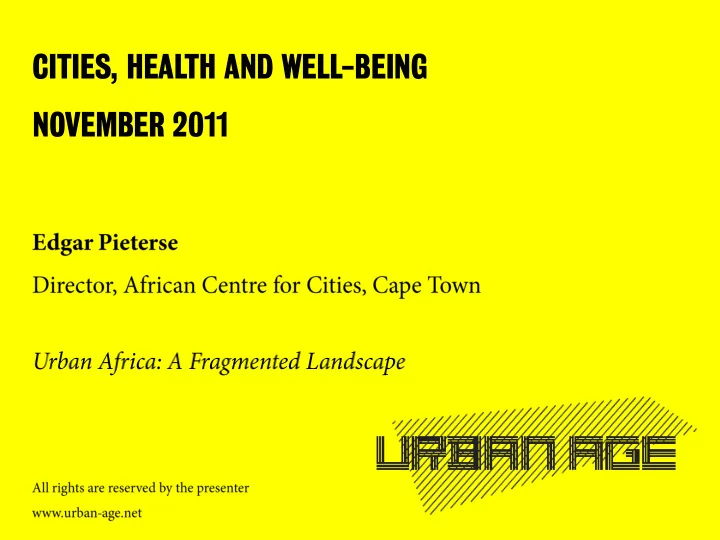

CITIES, HEALTH AND WELL-BEING NOVEMBER 2011
Artists: www.jr-art.net/ Urban Africa: A Fragmented Landscape Edgar Pieterse | African Centre for Cities | 18 November 2011
Maybe Kinshasa shouldn ’ t even try to follow the West. We could not catch up with it even if we tried. We would do better to follow the last one in the race, the hungry one, and follow the rhythm of his footsteps, the time of that hungry one. Of course, hunger signifies a lack of freedom. Somehow we have lost the equilibrium between the physical question and the beyond that creates the freedom. Ready to accept and eat about anything, hunger reduces one to mere survival. But beyond that hunger lies something else… Kinshasa is not only stomach. We have the capacity to open up to that something else, but we haven ’ t yet managed to surpass the problem of hunger, of death, of illness, of suffering. We haven ’ t yet overcome the rupture. And then, hunger and death do not only signify closure, they also enable the creation of an opening, if not physically then at least mentally… - Vincent Lombume Kalimase, Artist from Kinshasa, DRC
Urbanization 2050: 1.2 billion 61% of Pop Urbanization 2030: 800 million 50% of Pop Urbanization 2010: 380 million 39% of Pop Urbanization 1990: 199 million 31% of Pop Source: UN-Habitat, 2008
Source: Pardee Centre & Institute for Security Studies, 2011
African population below $2.15 per day, per region Central Africa($2.15) Eastern Africa($2.15) Northern africa($2.15) Southern Africa($2.15) Western Africa($2.15) 250 200 Mil People 150 100 50 2008 2012 2016 2020 2024 2028 2032 2036 2040 2044 2048 Year Source: Pardee Centre & Institute for Security Studies
Africa GDP Per Capita income trends by region, 2005-2050 AFP Central Africa AFP Eastern Africa AFP Northern Africa AFP Southern Africa AFP Western Africa 14 Thousand dollars per capita (PPP) 12 10 8 6 4 2 2008 2012 2016 2020 2024 2028 2032 2036 2040 2044 2048 Year Source: Pardee Centre & Institute for Security Studies
Structural poverty, inequality & limited employment manifest in Slum Living as the norm Region % Slums Moderated Severely (1-2 deficiencies) (3-4 deficiencies) Sub-Saharan Africa 62 63 37 LAC 27 82 8 Southern Asia 43 95 5 [1. overcrowding; 2. informal housing; 3. lack of access to water and sanitation; 4. insecure tenure]
• Limited state understanding or STRUCTURAL appetite to address urbanization OBSTACLES: • Small & skewed formal economies — limited tax base • Regulations that penalize informality • Discrimination re identity politics of affiliation • Entering global markets with ltd leverage or unified positions • Costs of large-scale dysfunction paid by voiceless slum dwellers
Built manifestation: extreme splintered urbanism — slum neglect combined with enclave elite urbanism
Despite the promising economic growth prospects for Africa of late, there is no readily available or acceptable economic and community development model to address the mutually reinforcing drivers of structural exclusion and poverty, at scale.
Illustrative case: KHAYELITSHA, CAPE TOWN
Khayelitsha, Cape Town Khayelitsha township was developed from 1983, 35 km outside central Cape Town. The original township layout could accommodate up to 250.000 people. Currently there are 600.000- 800.000 people living in Khayelitsha. The area suffers from the worst levels of violent crime in city.
VPUU Method Concept Strategy: Articulate Vision: Build safe and Social crime prevention: • • sustainable communities by public health approach of reducing social, cultural, ECD, school aged economic and institutional interventions & employment exclusion. programmes Approach: Sustainable Institutional crime • • economic model based on prevention: manage public voluntarism, partnerships, spaces, data, community accountability, responsibility policing & community ownership Situational crime prevention: • surgical design interventions to establish a sense of place
Project Instruments • Establish “ Safe Node Areas ” Capital Infrastructure • Social Development Fund (SDF) Small Infrastructure, Community Projects, Community Cohesion, Gender Equity, Reduce Violence • Supporting Measures Capacity Building, Operation And Management Concepts • Ongoing Monitoring & Evaluation Constant Assessment, Review, Improve
Site C Denel Site C: Nolungile Station Precinct
Perception of safety Distribution of crime: Overall
Priority points and areas Distribution of crime: identified by Baseline Murder Consultation Group
- Activity Box Trading - Active Box Recreation - Safe sports fields - Safe node of multi-use activities - Civic squares - House of learning
Murder rate per 100,000: - 2003/04: 75 - 2009/10: 46 - 39% reduction - Also, almost no murders in public spaces.
Institutionally savvy Regionally Meaningful connected processes Resonant Design Economic Works with dimension spatial grain Social Maintenance programming & repair
Implications for urban health practice & debates • Acknowledge and accept the “ people-as- infrastructure ” perspective • Accept the need for both government-driven interventions and grassroots activism, with a focus on strategic articulation • Intermediation is key • Multi-dimensional health perspectives serve as powerful tools to address both urban poverty and inequality
Improving health outcomes via employment interventions Green Cultural & art services infrastructure Public works Care economy
“ There is a hiatus somewhere, a void, and this void needs to be filled. It has to be filled by us, the inhabitants of this city … The city belongs to all of them. And they all have to constantly reinvent their own myths, their own stories of the street, to keep going and to offer themselves a semblance of direction for this world that keeps slipping through their fingers. The city is indeed a never ending construction . ” - V.L. Kalimase
Thank You.
Recommend
More recommend